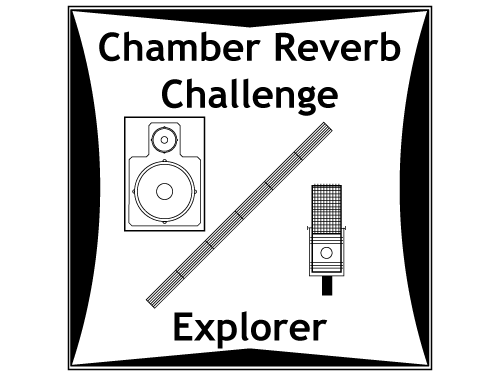Having studied and auditioned your spaces, it’s time to move on to the next step: recording the reverb that might become your chamber reverb sound.
Recording Your Reverb
1. I am recording in a room
Return to the two spaces you explored in Explorer Challenge #2 and try record the reverberant sound of the space. All you need is a sound source and a sound recorder.
Sound Source
You’ll want to observe the shifts in sound quality when you change sound source locations within a room, and you’ll also want to be able to compare the two rooms. You’ll be more productive if your sounds are created as consistently as possible. If you are playing back a sound sample via the loudspeaker in a mobile device or portable sound system, you are able to consistently energize the space. If you are using a hand clap, singing, or playing an instrument, try to create the same sound at the same level with the same tempo each and every time. You’ll likely find short sounds and phrases more useful than a long example. Percussive sounds are very revealing of your room’s decay, at the end of each transient impact. Sustained sounds are also revealing of the spectral qualities of your spaces, but keep them to about 5 to 10 seconds in duration. A great goal: one percussive sound (hand clap, snare sample) and one short musical phrase (about 4 bars).
- Hand Clap
- Sing
- Play an Instrument
- Mobile Device/Portable Sound System
Source Location
Based on your observations in the Explorer Challenge #2, choose your preferred source location, or try them all.
- Corner of the Room
- (Near the) Center of the Room
- Next to a Reflective Surface
Sound Recorder
You will be recording reverb using any device conveniently available. If you have a Digital Audio Workstation and the necessary audio interface, you are ready to record. If you plan to use a mobile device, please note that many voice memo recording applications may modify the sounds you record with signal processing. Such apps intend to capture spoken word with maximum intelligibility. They might try to attenuate low level noises, and automatically adjust the gain of the recorded signal to ensure a good level despite unpredictable levels. To capture the sound of your chamber, in which we want to hear the full decay of your space without level changes, we must use an app that allows us to defeat any noise reduction and automatic gain control algorithms.
Recorder Location
Based on your observations in the Explorer Challenge #2, choose your preferred sound receiver location, or try them all. Remember, you are recording the reverb of the room, not the original direct sound source. A reverb plugin offers a wet/dry mix that we often set to 100% wet and mix in the dry signal to taste later, when we mix. Aim for 100% wet by capturing as much of the sound or your chamber and as little of the direct sound from your sound source as possible. We like to at least block the line of sight from sound source to sound recorder, using an intervening room partition, or by adding something to block that path (furniture, gobo, etc.).
- Corner of the Room
- (Near the) Center of the Room
- Next to a Reflective Surface
Notes & Observations
With the sound of your chamber now recorded, it is possible to make closer observations than was possible in Chamber Explorer #2, when you could only listen live. You can audition each recording as many times as you wish. You can play any two different sound recordings one after another, and make fine comparisons between the two.
- Compare and contrast within each space:
- Which source/receiver locations within the space created the longest decay time? They might be quite similar, but which locations seemed to best showcase the sound of the room and suppress the direct sound of the source?
- Describe your hypothesis for why the preferred source/receiver location pair captured the longest decay time? Try to tie what you hear in the sound to what you see in the associated architecture.
- Which source/receiver location simply sounds best for the space? The reasons for this preference might be about the length of decay, the frequency content of the decaying energy, or whatever grabs your ears.
- It can be a challenge to describe sound in a way others can understand, but try to describe what it is about your preferred sound example that makes it your top choice.
- Describe your hypothesis for why the preferred source/receiver location pair is best? Try to tie what you hear in the sound to what you see in the associated architecture.
- Compare and contrast the two spaces:
Using your preferred recorded examples for each space:
- Which space has the longest decay time?
- What is your hypothesis for why this space has the longest decay time? Try to tie what you hear in the sound to what you see in the associated architecture in each room.
- Which space simply sounds best? The reasons for this preference might be about the length of decay, the frequency content of the decaying energy, or whatever grabs your ears.
- It can be a challenge to describe sound in a way others can understand, but try to describe what it is about your preferred space that makes it your top choice.
- Describe your hypothesis for why the preferred space is best? Try to tie what you hear in the sound to what you see in the associated architecture.

